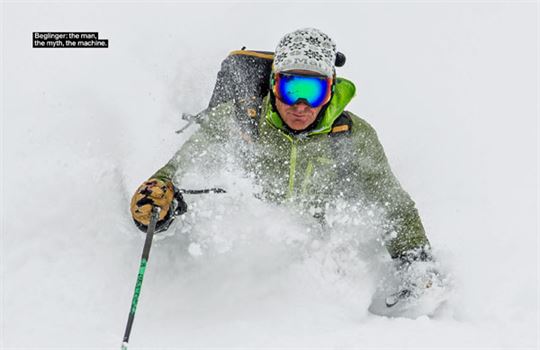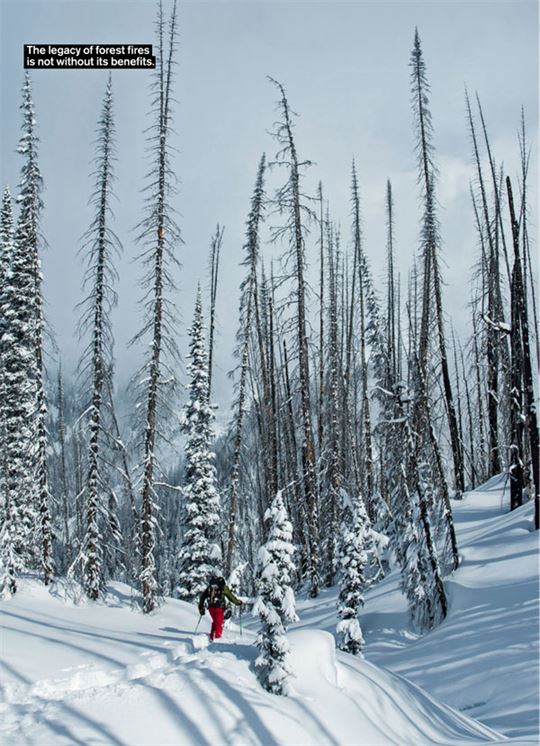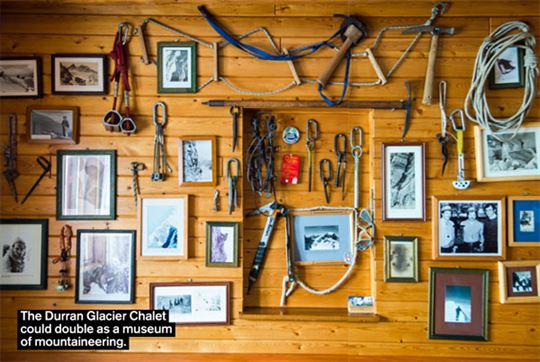Selkirk Mountain Experience’s playground now includes three chalets and unlimited turns to be earned.
_By Matt Coté Photos Bruno Long
Our helicopter pilot navigates the low cloud relaxed and confident. We hug interweaving ridgelines while skeptically absorbing the view of the damp valley below. It’s been an unseasonably warm February in B.C., but as we follow Carnes Creek past Tumbledown Mountain, a dry, white landscape reveals itself above. It’s a welcome sight, since almost all other backcountry operations in the Southern Interior are shut down or running at reduced capacity. Selkirk Mountain Experience (SME), though, is nice and high—it’s still winter up here. The Durrand Glacier Chalet appears like a mirage amid stoic stands of sedimentary rock and our 15-minute flight north of Revelstoke is over.
As our group swaps places with the outgoing guests, they issue us thumbs-ups and knowing grins under the helicopter’s heavy wash. A few minutes later we’re snacking on baked sweets inside the chalet—an elaborate reproduction of a Swiss mountain hut that betrays the fact it’s on another continent. In total, there are a dozen of us and as we introduce ourselves, I find I’m in the company of only two other Canadians, along with one Brit, a German and the rest Swedish. All in their 30s and 40s, the Swedes are clearly cut from Viking gene pools. Everyone looks ripped.
Connect the huts_
Ruedi Beglinger presents himself next as he explains the impressive amenities, which includes even satellite Wi-Fi, and that each of us actually has an individual room—score! Beglinger is SME’s founder, a Swiss expat and accomplished mountaineer and guide. His manner is cordial and his posture relaxed, motioning with expressive hands while explaining the lodge and the week ahead.
Next, he introduces his lead guide, Alex Geary, an Australian; his chef, Engelbert, from Austria; and his two young lodge-hands, Ewalt and Nicole, both Swiss and in their early twenties. From the glaciers to the size of the terrain, the company and the food—it feels as if I flew to Europe. Or as Jamie, a well-travelled energy consultant from Toronto, puts it: “This is an out-of-country experience!”
Adding to that flavour is a new hut—the Empire Lake Chalet—that serves as one of two satellite bases that SME guests can now reach on skis from the Durrand Chalet. The SME repertoire has also long-included the Moloch hut. In each case guests are given a bedsheet and a small amount of food to carry to the next chalet, where either Beglinger, his wife, Nicoline (absent this week), or his chef, Engelbert, continues the catered experience.
Now able to connect all three huts in a single trip, SME is promoting this traverse as the “Canadian Haute Route”—referencing the famous European high-mountain journey from Zermatt, Switzerland, to Chamonix, France. Over in Banff National Park, this comparison is also used for the Wapta Traverse, which shares the somewhat exclusive trait of being serviced by huts the whole way.
***************************************************************************
The elevation here is the saving grace. It’s protected the terrain from the onslaught of pineapple expresses this month—warm storms from the Pacific that rinse away snow. As such, Beglinger opts to stay high—his usual tactic, anyway. “We’re going to go to Woolsey Peak,” he says, motioning in a direction obscured by falling snow.
Karl, one of the Swedes who’s aware of our guide’s militaristic reputation, asks, “Ruedi, I usually have to pee a lot, is it all right to stop when I need to?” Beglinger laughs out loud, and answers, “You can pee whenever you want, so long as I don’t have to help!”
Geary takes the tail as we’re split into two groups. I elect to follow Beglinger’s lead, which carries a surprisingly humane pace given his rep. Jamie, Florian (our German) and four other ambitious Swedish souls make the front of our train. While walking, Beglinger chats merrily about his daughters, Florina and Charlotte, and how the latter studies opera in Vancouver. “I don’t know why,” he says, “but Canadians are great singers!”
After a 600-vertical-metre climb through the milk, both groups are together atop the broad mountain and visibility is surprisingly good on the sporty open face below us. Before we have time to crack another joke though, Beglinger’s skins are off and he’s skiing. Grace, our Brit, looks over to Geary stunned, who simply grins as Beglinger shouts back: “’Kay guys, we go now, five turns apart!”

There’s no time wasted here—above all else, SME is about skiing. Transitions are quick and sliding on snow takes precedence over chatting. To boot, there’s a minimum required amount of fitness required, and a minimum amount of downhill ability. But SME does a good job of screening its guests, which makes our own two groups jell almost perfectly.
Every guest, male and female, carves beautifully and naturally back down to treeline, giggling at the first taste of light, billowy Selkirk powder. Avalanche conditions are good, the tree runs are filling in with new snow and stress is low.
Back “home,” we’re met with a rich Swiss meal that feels as if we’re being overpaid in calories. No worries, though, we’ll burn them tomorrow.
**********************************************************************************
‘‘Day three is an ambitious one, with both groups moving at the same pace and bagging 1,800 metres over three runs!’’
The week follows a clock-like rhythm: breakfast at seven, leave the lodge at eight, ski all day, back by three. Then the nights are yours to play guitar, have a drink or loosen up in the sauna—a great muscle aid for the energy output required.
In the following days Jamie, Florian and I stay glued to Beglinger, challenging ourselves to match his stride. The pace is steady but sustainable—anywhere from an hour or two of walking and taking breaks in designated spots. The sometimes terse imperative to move is a result of the seriousness of the terrain. In big mountains there are only so many places to safely stop, and you only have so much time to keep on track.
Day three is an ambitious one, with both groups moving at the same pace and bagging 1,800 metres over three runs. The Durrand Glacier itself is our first. With a steep start that mellows out to a wide, uniform 35-degree snowfield with a rocky ridge to its left as a handrail, the 600-metre-long run is smooth and effortless.
We ski a minimum of two to three big descents—400-800 metres long—each day. Most of us are able to keep up with that comfortably. Though Karl and Grace do sit out day three, resting up to maximize their energy for our traverse to Empire Lake.
************************************************************************
‘‘This is an out-of-country experience!’’
Civilized hut-based backcountry skiing in Canada, one could argue, is Beglinger’s legacy. After arriving here in 1977 and working for several years at other operations, he wanted a place he could more aptly share his distinct European style of guiding. “The vision was just a hut and skiing,” he remembers. “It’s not like I set out to build a Swiss Disneyland. The hard part was convincing the government that ski-touring lodges were an industry,” he says. But he did just that, and in 1985 the Durrand Chalet went up.
The Moloch hut followed three years later, but it took another 27 loops around the sun for Beglinger to build the more contemporary Empire Lake hut. “It was inspired by the melting of glaciers,” he explains while expressing a deep concern about climate change and stewardship of wild places.
As we walk on past the bottom of a tree run called Morning Glory and an old, burnt forest, some of the group takes an option to head back home with Geary. Lactic acid is building up in our legs and the day’s route is programmed with an early out for those who need it. As I soldier on behind Beglinger, he explains further that the granite slab where the Empire Lake Chalet now sits, at the foot of the Forbidden Glacier, had ice on it only 10 years ago. Part of the motivation to build again was to have a low-impact base to enjoy these glaciers while they’re still around. The other was to access easier terrain and have another hut that’s usable even during difficult avalanche conditions. The Moloch hut, in comparison, is big game. It’s not always possible to access it, and the terrain around it is SME’s most complex and challenging.
“Empire Lake and the relaxed-pace program is my retirement plan,” jokes Beglinger as he explains that they’re doing more now to accommodate groups of different skill levels as hut-based skiing becomes more popular.
******************************************************************************
Throughout the rest of the week, our two groups dance closely with each other, competing for fresh tracks—of which there are plenty.
Nicole and Ewalt are with us as often as they can be when they’re caught up on chores. Together we ski Zigerschlitz, named for Nicole’s home village back in Switzerland, which elates her. “I feel like I won the lottery with this job,” she screams, her sunglasses inadequately shielding her eyes from faceshots. Meanwhile, Ewalt displays impressive stamina after hours of snow-shovelling this week—160 cm has fallen.
The favourite descents by now are the long ones that lead from the shoulder of either Goat Mountain or Tumbledown to the canyon below. These are wide, pillowy slide paths named after Arthurian characters: Merlin, Morgan Lefaye, Mordred. Starting way up in the alpine, some of these runs approach 1,000 metres in length when connected with higher ones—the catch is you have about an hour-long tour back to the Durrand Chalet to finish the day. Getting home with skins on is sometimes a tough mental hurdle if you’re used to a sliding finish.
**********************************************************************************
‘‘We bounce off the sides of the low-angle gully in all directions, like ping-pong balls through a powder halfpipe.’’
On our last day, after a tour back up from the canyon, a few of us feel we could do more, and there’s still time left. Geary collects Karl, Florian and me and takes the group down Escalator for a bonus lap. We bounce off the sides of the low-angle gully in all directions, like ping-pong balls through a powder halfpipe. At the bottom even Geary, who does this every day, is wide-eyed, “I think that’s the fastest I’ve ever skied that!” Not bad for a week where the treeline skiing started out so nuked.
On the last night Beglinger hosts a traditional Swiss fondue, as he does at the end of every trip. We’re in a calorie-deficit at this point, since we’ve averaged about 1,600 metres a day—and all of us gorge shamelessly.
The next morning we find ourselves reluctantly boarding the helicopter again. Beglinger comes to wish us adieu. Ice and snow fade back into the clouds and we descend into the streets of sodden Revelstoke, where little has changed. Stepping out of ski boots, it’s hard to reconcile the majesty of the previous moment with the penetrating normality of this one. With heads still in the clouds and lactose stuck to our guts, our international group of new friends hug and say our goodbyes, counting the days until this same time next year.
**********************************************************************
Haute cuisine
The list of important factors that creates a well-rounded hut experience include ski quality, comfortable lodgings, sauna logistics and, of course, culinary virtue. The latter amenity is geared toward providing guests with a breakfast that will fill the tank with efficient fuel for a day of contouring and kick-turning your way through the mountains. Lunch is focused on maintaining your energy levels, with a spread of sandwiches, homemade energy bars, fruit and baked goods that will get you that extra lap on the skin track. Before or after your post-ski sauna session, chef Engelbert provides the group with a small snack that would qualify as a meal in most places. Homemade samosas and spanakopita are just some of the options that will tide you over until the Swiss bell is rung, signalling the start of dinner. The calorie-rich meals are something to behold, with made-from-scratch soups, exquisite mains coupled with fresh bread and a selection of desserts that leave everyone satisfied and with their tanks filled for another day of walking tomorrow.
—Bruno Long
**********************************************************************
The Durran Glacier Chalet could double as a museum of mountaineering.
New kid on the rock
We can see the Empire Lake Chalet far below us, a speck at the bottom of rolling, complex terrain that Ruedi now has to guide us through. He quickly leads the way, yelling at us to continue moving swiftly through each convex roll, steep face and rocky sidehill. He skis and contours through the area with grace, leading us all to the safety of the valley bottom and toward an evening at the Empire Lake Chalet.
We are greeted by a simple, yet elegant hut in the shadow of Mt. Durrand’s north face. Clean architectural lines, a well-thought-out layout and efficient design make you feel as though you’re living inside an actual Swiss-made watch. It comes as no surprise that the battery making it all tick is Beglinger, who dreamt up the concept, drew the blueprints himself and built the hut with his own hands. As we share dinner, enjoy a glass of wine and toast to the new chalet, I get a sense from Ruedi that this could well be the last big addition to his 30-year legacy in these mountains. Judging from the expanse of ski terrain at close proximity to the hut, it feels as if the future of that legacy is, much like the hut’s granite slab foundation, solid and enduring.
—Bruno Long
Tough love at Moloch
Not just a winter destination, the Moloch Chalet is also the beating heart of the summer rock-climbing and hiking programs at SME. We skied as close as we could safely get, considering the recent snowfall, high winds and avalanche hazard. You could immediately tell why the location for the Moloch was chosen as an alpine paradise. Wonderfully situated among tumbling glaciers, nearly vertical granite faces and imposing ridge lines, the chalet is where you want to be when avalanche conditions are stable enough for passage through the complex terrain, allowing for high-alpine ski runs that will excite even the most seasoned lodge visitors. Perched in the shadow of the impressive north face of Mt. Moloch, the chalet provides guests with a base for easy access to the alpine without the long approach that usually goes hand in hand with skiing bigger lines. Unfortunately for our group, conditions didn’t allow for a visit to the chalet, with a steep roll and stiff windslab blocking our way. However, just catching a glimpse of the ski potential in the area was enough to light a fire in all of us, creating a burning desire to return to the Moloch Chalet and realize some of that potential for ourselves.
—Bruno Long







